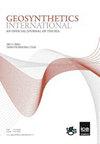Shear modulus of sand-rubber mixtures: element testing and constitutive modeling
IF 2.8
2区 工程技术
Q2 ENGINEERING, GEOLOGICAL
引用次数: 0
Abstract
In this study, a series of resonant column tests was conducted to measure the shear modulus of sand-rubber mixtures at small strain amplitudes (i.e. between 10−4% and 10−4%), considering different rubber percentages and confining stress levels. The results were then combined with data obtained by dynamic hollow cylinder tests to investigate shear modulus degradation of the mixtures over a wider shear strain range. Based on the test results, a new expression was proposed to improve the prediction of maximum shear modulus of sand-rubber mixtures using the modified equivalent void ratio concept. A new constitutive model was also developed for estimation of strain-dependent shear modulus of the mixtures based on the modified hyperbolic framework. The shear modulus of the mixtures was found to be a function of rubber percentage, confining stress, the modified equivalent void ratio and the relative shear stiffness of rubber and sand. The experimental data and the developed models showed that the shear modulus decreased with rubber percentage and increased with confining stress. Moreover, the reference shear strain of the modified hyperbolic model increased with both rubber percentage and confining stress while its curvature coefficient increased more considerably with rubber percentage compared to the confining stress.砂橡胶混合物的剪切模量:元素测试和构成模型
在这项研究中,考虑到不同的橡胶比例和约束应力水平,进行了一系列共振柱试验,以测量砂橡胶混合物在小应变振幅(即 10-4% 到 10-4%)下的剪切模量。然后将试验结果与动态空心圆柱体试验获得的数据相结合,研究混合物在更大剪切应变范围内的剪切模量退化情况。根据试验结果,提出了一个新的表达式,利用修改后的等效空隙率概念来改进砂橡胶混合物最大剪切模量的预测。此外,还开发了一种新的构成模型,用于估算基于修正双曲框架的应变剪切模量。研究发现,混合物的剪切模量是橡胶百分比、约束应力、修正等效空隙率以及橡胶和砂的相对剪切刚度的函数。实验数据和建立的模型表明,剪切模量随橡胶比例的增加而降低,随密闭应力的增加而升高。此外,修正双曲线模型的参考剪切应变随橡胶百分率和密闭应力的增加而增加,而与密闭应力相比,其曲率系数随橡胶百分率的增加而增加。
本文章由计算机程序翻译,如有差异,请以英文原文为准。
求助全文
约1分钟内获得全文
求助全文
来源期刊

Geosynthetics International
ENGINEERING, GEOLOGICAL-GEOSCIENCES, MULTIDISCIPLINARY
CiteScore
6.90
自引率
20.00%
发文量
91
审稿时长
>12 weeks
期刊介绍:
An online only, rapid publication journal, Geosynthetics International – an official journal of the International Geosynthetics Society (IGS) – publishes the best information on current geosynthetics technology in research, design innovation, new materials and construction practice.
Topics covered
The whole of geosynthetic materials (including natural fibre products) such as research, behaviour, performance analysis, testing, design, construction methods, case histories and field experience. Geosynthetics International is received by all members of the IGS as part of their membership, and is published in e-only format six times a year.
 求助内容:
求助内容: 应助结果提醒方式:
应助结果提醒方式:


